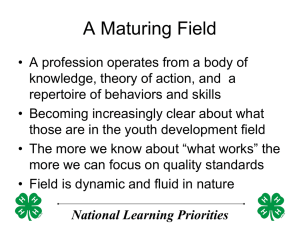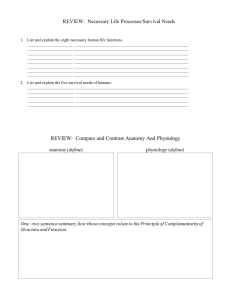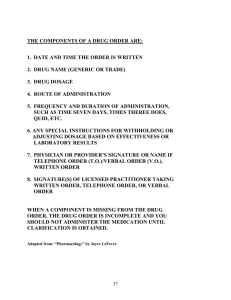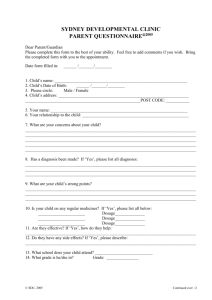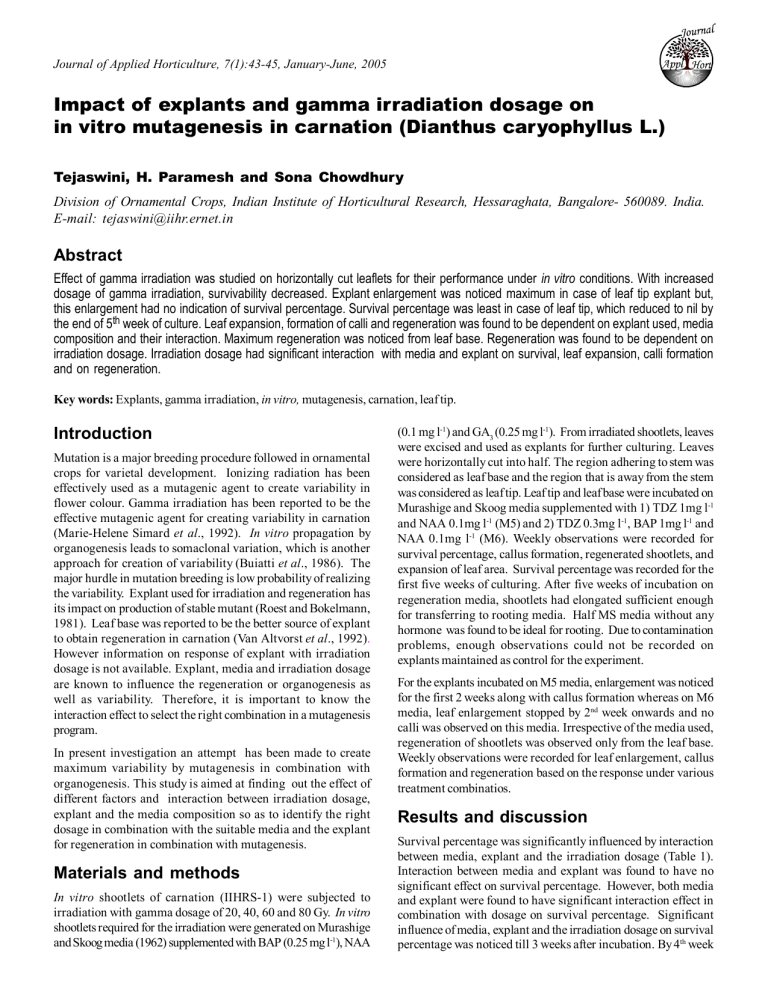
Journal of Applied Horticulture, 7(1):43-45, January-June, 2005 Impact of explants and gamma irradiation dosage on in vitro mutagenesis in carnation (Dianthus caryophyllus L.) Tejaswini, H. Paramesh and Sona Chowdhury Division of Ornamental Crops, Indian Institute of Horticultural Research, Hessaraghata, Bangalore- 560089. India. E-mail: tejaswini@iihr.ernet.in Abstract Effect of gamma irradiation was studied on horizontally cut leaflets for their performance under in vitro conditions. With increased dosage of gamma irradiation, survivability decreased. Explant enlargement was noticed maximum in case of leaf tip explant but, this enlargement had no indication of survival percentage. Survival percentage was least in case of leaf tip, which reduced to nil by the end of 5th week of culture. Leaf expansion, formation of calli and regeneration was found to be dependent on explant used, media composition and their interaction. Maximum regeneration was noticed from leaf base. Regeneration was found to be dependent on irradiation dosage. Irradiation dosage had significant interaction with media and explant on survival, leaf expansion, calli formation and on regeneration. Key words: Explants, gamma irradiation, in vitro, mutagenesis, carnation, leaf tip. Introduction Mutation is a major breeding procedure followed in ornamental crops for varietal development. Ionizing radiation has been effectively used as a mutagenic agent to create variability in flower colour. Gamma irradiation has been reported to be the effective mutagenic agent for creating variability in carnation (Marie-Helene Simard et al., 1992). In vitro propagation by organogenesis leads to somaclonal variation, which is another approach for creation of variability (Buiatti et al., 1986). The major hurdle in mutation breeding is low probability of realizing the variability. Explant used for irradiation and regeneration has its impact on production of stable mutant (Roest and Bokelmann, 1981). Leaf base was reported to be the better source of explant to obtain regeneration in carnation (Van Altvorst et al., 1992). However information on response of explant with irradiation dosage is not available. Explant, media and irradiation dosage are known to influence the regeneration or organogenesis as well as variability. Therefore, it is important to know the interaction effect to select the right combination in a mutagenesis program. In present investigation an attempt has been made to create maximum variability by mutagenesis in combination with organogenesis. This study is aimed at finding out the effect of different factors and interaction between irradiation dosage, explant and the media composition so as to identify the right dosage in combination with the suitable media and the explant for regeneration in combination with mutagenesis. Materials and methods In vitro shootlets of carnation (IIHRS-1) were subjected to irradiation with gamma dosage of 20, 40, 60 and 80 Gy. In vitro shootlets required for the irradiation were generated on Murashige and Skoog media (1962) supplemented with BAP (0.25 mg l-1), NAA (0.1 mg l-1) and GA3 (0.25 mg l-1). From irradiated shootlets, leaves were excised and used as explants for further culturing. Leaves were horizontally cut into half. The region adhering to stem was considered as leaf base and the region that is away from the stem was considered as leaf tip. Leaf tip and leaf base were incubated on Murashige and Skoog media supplemented with 1) TDZ 1mg l-1 and NAA 0.1mg l-1 (M5) and 2) TDZ 0.3mg l-1, BAP 1mg l-1 and NAA 0.1mg l-1 (M6). Weekly observations were recorded for survival percentage, callus formation, regenerated shootlets, and expansion of leaf area. Survival percentage was recorded for the first five weeks of culturing. After five weeks of incubation on regeneration media, shootlets had elongated sufficient enough for transferring to rooting media. Half MS media without any hormone was found to be ideal for rooting. Due to contamination problems, enough observations could not be recorded on explants maintained as control for the experiment. For the explants incubated on M5 media, enlargement was noticed for the first 2 weeks along with callus formation whereas on M6 media, leaf enlargement stopped by 2nd week onwards and no calli was observed on this media. Irrespective of the media used, regeneration of shootlets was observed only from the leaf base. Weekly observations were recorded for leaf enlargement, callus formation and regeneration based on the response under various treatment combinatios. Results and discussion Survival percentage was significantly influenced by interaction between media, explant and the irradiation dosage (Table 1). Interaction between media and explant was found to have no significant effect on survival percentage. However, both media and explant were found to have significant interaction effect in combination with dosage on survival percentage. Significant influence of media, explant and the irradiation dosage on survival percentage was noticed till 3 weeks after incubation. By 4th week Impact of explants and gamma irradiation dosage on in vitro mutagenesis in carnation 90 80 Perc en tag e 70 60 50 40 30 20Gy 40Gy 20 60Gy 80Gy 10 0 1st week 2nd week 3rd week 4th week 5th week Fig. 1. Survival percentage at various irradiation dosage as observed over various weeks after incubation 90 80 70 Perc en tag e Table 1. Effect (‘F’ value) of media, irradiation dosage, explant and their interaction on survival percentage Factor/ Week Interaction I II III IV V A 59.65** 5.86* 7.85* 9.09* 10.46* B 5.38* 10.84* 36.43** 42.12** 42.30** C 24.18** 23.39** 6.20* 0.62NS 0.32NS AxB 43.25** 30.01** 4.53* 6.99* 6.43* BxC 7.20* 7.97* 2.67* 0.91NS 0.98NS NS NS NS NS AxC 1.57 0.85 1.09 1.13 1.47NS AxBxC 6.64* 7.14* 21.25** 8.84 8.43* Note: A= Media, B= Dosage of gamma irradiation, C=Explant, x = Interaction, * = Significant at P=0.05 ; ** = Significant at P=0.01; NS = Non-significant. Table 2. Survival percentage observed for explants, media, irradiation dosage and their interaction Main effects Factor Survival (%) A1 36.87(39.93) A2 24.55(26.90) CD (P=0.05) 7.58 B1 B2 62.31(71.47) B3 37.42(40.74) B4 17.06(16.87) B5 6.05(9.16) CD (P=0.05) 10.72 C1 29.62(32.78) C2 31.80(34.05) CD (P=0.05) 7.58 Two way interaction Factor Survival (%) Factor Survival (%) Factor Survival (%) A1B1 B1C1 A1C1 38.09(41.62) A1B2 66.21(74.83) B1C2 A1C2 35.65(38.25) A1B3 57.61 B2C1 65.00 A2C1 21.15 A1B4 15.29(15) B2C2 59.62(68) A2C2 27.95(29.86) A1B5 8.35(5) B3C1 38.20(41.16) A2B1 B3C2 36.65(40.31) A2B2 58.41(68.12) B4C1 15.29(15.00) A2B3 17.23(16.56) B4C2 18.82(18.75) A2B4 18.82 B5C1 0 A2B5 3.74(4.16) B5C2 12.10(9.16) CD (P=0.05) A x B = 15.16 B x C = 15.16 A x C = 10.72 Three way interaction Factor Survival (%) Factor Survival (%) A1B1C1 A2B1C1 A1B1C2 A2B1C2 A1B2C1 59.97 A2B2C1 70.03 A1B2C2 72.45(83.00) A2B2C2 46.80(53) A1B3C1 61.79(69.83) A2B3C1 14.60(12.5) A1B3C2 53.43(60.00) A2B3C2 19.86(20.63) A1B4C1 30.58(30.00) A2B4C1 0 A1B4C2 0 A2B4C2 37.65(37.5) A1B5C1 0 A2B5C1 0 A1B5C2 16.71(10.00) A2B5C2 7.49(8.33) CD (P=0.05) A x B x C = 21.45 Note: A= Media, A1= M5 = MS basal media supplemented with TDZ 1mg l-1and NAA 0.1mg l-1, A2=M6 = MS basal media supplemented with TDZ 0.3mg l-1, BAP 1 mg l-1 and NAA 0.1 mg l-1 60 50 40 Survival(%) Leaf expansion Calli Regeneration 30 20 10 0 20Gy 40Gy 60Gy 80Gy Irradiation dosage Fig. 2. Response of explants for survival, leaf expansion, calli formation and regeneration, 5th week after incubation 100 M6 80 Percentage 44 M5 60 40 20 0 0 20 40 60 Irradiation dosage 80 Fig. 3. Percentage of regeneration observed on different media composition in response to irradiation dosage. (M6 = MS basal media supplemented with TDZ 0.3mg l-1, BAP 1mg l-1 and NAA 0.1mg l-1.; M5 = MS basal media supplemented with TDZ 1mg l-1 and NAA 0.1mg l-1) onwards, survival percentage was not influenced by explant. Survival percentage decreased over the weeks and it was comparatively higher on media supplemented with TDZ 1mg l-1 and NAA 0.1 mg l-1 compared to that on media supplemented with TDZ 0.3 mg l-1, BAP 1 mg l-1 and NAA 0.1 mg l-1. Leaf tip had higher survival percentage in the first two weeks and from 3rd week onwards, survival percentage was higher for leaf base. For the first two weeks survival percentage had no particular trend in relation with media and dosage. However, by 3rd week Impact of explants and gamma irradiation dosage on in vitro mutagenesis in carnation Table 3. Impact of explant, irradiation dosage and their interaction on leaf enlargement Media Factor ‘F’ value I week II week III week M5 Explant 43.87** 31.59* 1.63NS Dosage 88.67** 12.82* 27.27** Interaction 32.93** 20.12* 27.29** M6 Explant 4.50* 0.00NS Dosage 3.34* 4.77** Interaction 3.96* 11.96** Table 4. Influence of explant, irradiation dosage and their interaction on leaf calli formation Source of variation ‘F’ value I week II week III week Explant 15.25** 9.00** 1.51NS Dosage 110.47** 97.83** 56.87** Interaction 24.47** 51.10** 47.47** onwards, percentage of survival decreased with increased dosage (Fig. 1). Final observations taken in fifth week (Table 2) indicated that, survival was maximum when leaf base was used as explant (31.8 %), and on media supplemented with TDZ 1mg l-1 and NAA 0.1mg l-1 (36.87 %). LD50 can be fixed between 20 and 40 Gy, as the survival percentage noticed was 62.31 and 37.42, respectively. However, regeneration was maximum in case of 40Gy (Fig. 2). Hence, when mutation is being used in combination with regeneration, irradiation dosage can be fixed at 40Gy. On M5 media, leaf enlargement was found to be significantly influenced due to dosage, explant as well as their interaction. On M6, though similar influence was noticed in the first week, by 2nd week leaf enlargement was found to be independent from the explant used (Table 3). On M5 media, significant influence of dosage, explant and their interaction was noticed on the formation of calli (Table 4). 45 Dosage, media and their interaction were found to have significant influence on regeneration (Fig. 3). Maximum regeneration was noticed by 4th week from explants without irradiation on M6 (90.83%). When subjected to irradiation of various dosages, maximum regeneration (67.75 %) was noticed at 40 Gy. For the irradiation dosage of 40 Gy, maximum regeneration was noticed on M6 media (Fig. 3). In conclusion, the study indicated gamma irradiation at 40 Gy to be ideal dosage for mutagenesis when mutagenesis is used in combination with regeneration. Survival percentage reduced with increased dosage of gamma irradiation. However, regeneration was found to be ideal at around LD50 dosage. Maximum regeneration could be realized on M6 media. References Buiatti M., F. Gimelli, R. Venturo, P. Bogani and T. Picconi, 1986. Interclonal variability induced in vitro and in vivo propagation in a vegetatively propagated plant, the carnation. In: Semal S (Ed.) Somaclonal Variations and Crop Improvement. Martinus Nijhoff Publishers Dordrecht (NL) pp. 251-256. Marie-Helene Simard, Nicole Michaux-Rferriere and Andre Silvy, 1992. Variants of carnation (Dianthus caryophyllus L.) obtained by organogenesis from irradiated petals. Plant Cell and Organ Culture, 29: 37-42. Murashige, T. and F. Skoog, 1962. A revised medium for rapid growth and bioassays with tobacco tissue cultures. Physiologia Plantarum, 15: 473-497. Roest S. and G.S. Bokelmann, 1981. Vegetative propagation of carnation in vitro through multiple shoot development. Scientia Horticulturae, 14: 357-366. Van Altvorst, A.C., H.J.J. Kochorst, T. Bruinsma, J. Jansen, J.B.M. Custers, J. De Jong and J.J.M. Dons, 1992. Adventitious shoot formation from in vitro leaf explants of carnation (Dianthus caryophyllus L.). Scientia Horticulturae, 51: 223-235.
